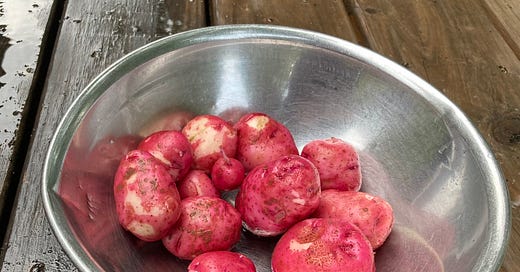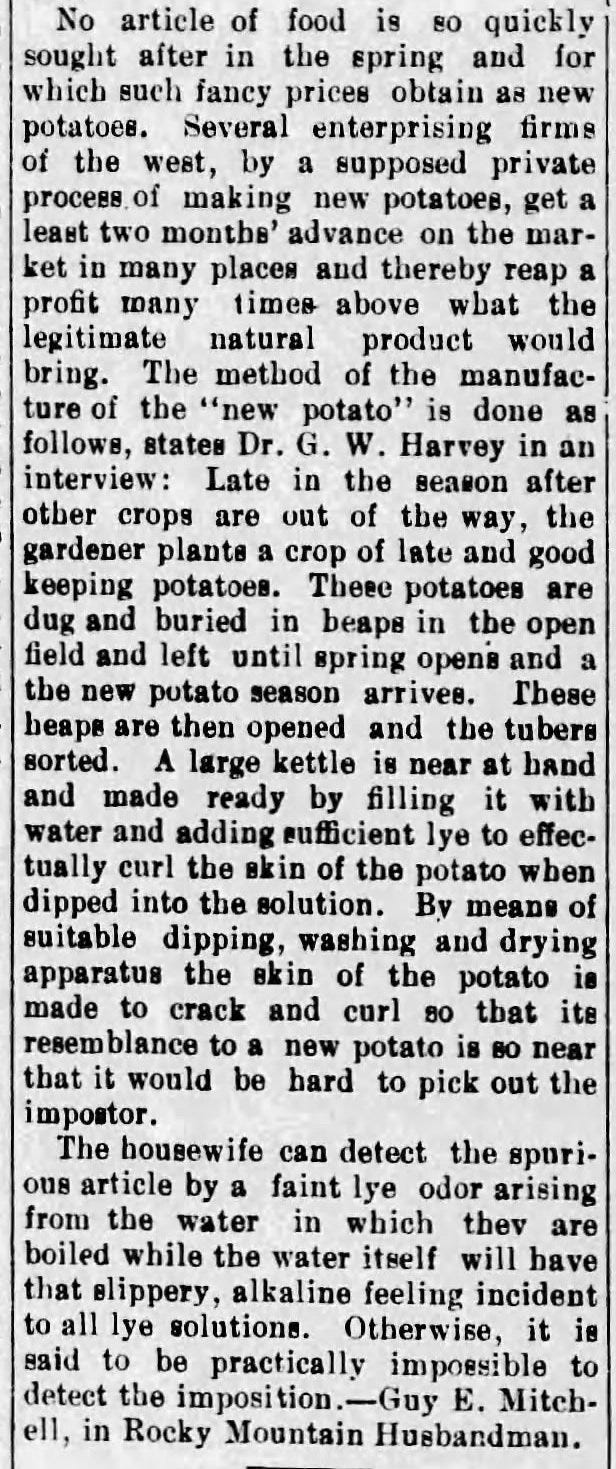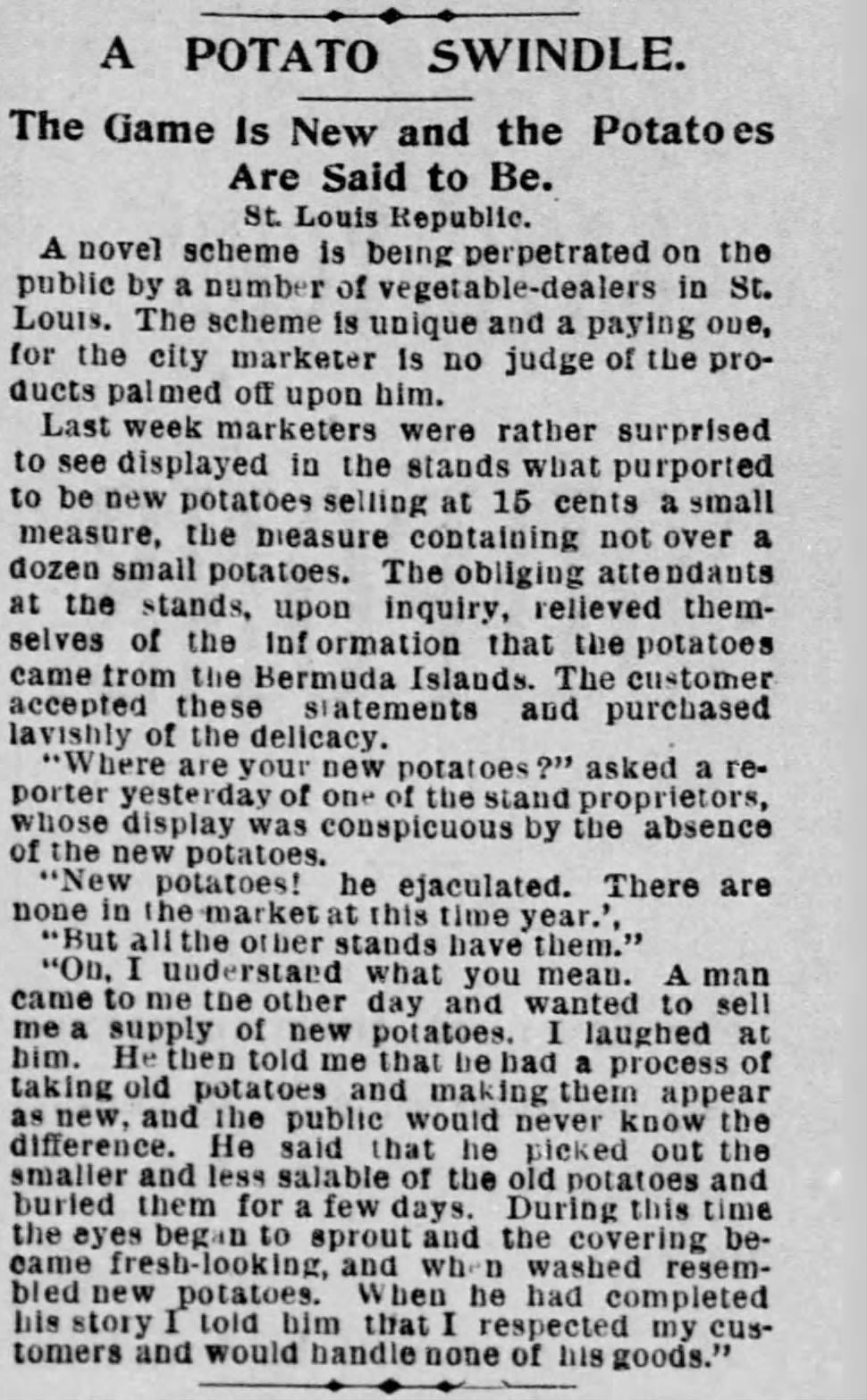I’m not much of a gardener. I enjoy planting seeds and watching them grow, but I lack the organization and drive that would keep things looking tidy. My beds get weedy and overrun, and I frequently put off tasks that would increase my chances of success, like staking my tomatoes and putting netting over my lettuce. The wild rabbits that live in my neighbors’ yards have enjoyed more salads from my garden than I ever will.
I am, however, pretty good at producing potatoes. Probably because they’re ridiculously easy to grow. Extra easy, since I’m employing something called the “Ruth Stout Method”, which involves throwing pieces of seed potato onto the ground and covering them with straw. It really works, and as a consequence, Ruth Stout’s 1961 book, Gardening Without Work: For the Aging, the Busy & the Indolent (of which I am two out of three) has become my manifesto.
In late March, at planting time, I’m not even bending over, but, two months later, Nature delivers her bounty.
Just-dug new potatoes are amazing. The complexity and freshness of taste are like nothing else I’ve ever eaten. The best way to prepare them is the simplest: boiled in salty water until fork-soft, then served with lots of good butter.
Homegrown tomatoes get all the adulation and love, but new potatoes from your own garden are just as good, if not better.
I’ve eaten plenty of supermarket new potatoes and farmer’s market new potatoes—at four dollars a pound—but none have ever been as tasty or as sweet as those I’ve just dug from my own garden. Either I’m high on my own supply, or the sugars and flavor compounds in fresh potatoes are highly perishable, unable to survive the brief trip from commercial farmer’s field to consumer’s table, because I’ve never eaten any potato that comes close.
Last year, I was talking about this with my lawn guy, Doug, one of nature’s sovereign aristocrats, who tells me that as a child he remembers eating new potatoes straight from the garden, uncooked, and being delighted with them.
I, unfortunately, do not remember eating potatoes from our childhood garden. We usually had a garden when I was a child. I remember being frequently chain-ganged by my parents into weeding that garden—dreary, hot, dusty work in the Central Valley sun. But I don’t remember eating any potatoes from it, new or old, cooked or raw. I don’t even remember my parents growing potatoes. Maybe they didn’t.
So, it was a complete surprise when, two years ago, I pulled my first small potatoes out from under Ruth Stout’s straw, boiled and ate them. It was like a whole new category of flavors were opened up to me. I had never tasted anything so perfectly potato-y and delicious.
That’s why, I suppose, people used to go bonkers for new potatoes. If you read old newspapers, as I frequently do, you’ll see that in the early spring, they were being shipped in from places like Bermuda at great cost. And you’ll find oddities like multiple warnings about counterfeit new potatoes.
Fifteen cents for a small container of potatoes in 1901 is serious money, which is why the above is not the only story about fake new potatoes…
On the one hand, exposing these scams falls into the general turn-of-the-last-century movement to clean up America’s grossly adulterated food supply. (See Upton Sinclair for more details.) On the other hand, if someone sold me old potatoes masquerading as new, I’d be pretty cheesed off.
Of course, the punchline is that all of the “new” potatoes in our supermarkets are old potatoes, picked in the spring in distant fields and held in storage, like apples, to be trotted out later. New potatoes aren’t just undersized potatoes, they’re super fresh potatoes, dug out of the ground a few hours before eating. Their skins are paper thin and peel off when you wash them too vigorously. Let them sit for a couple of days, and the skins get thick and the sweetness goes away. This is now a supermarket “new” potato, another mundane lump of starch.
I am adamant on this point. If your presumptuous/fancy restaurant menu mentions “new potatoes” they better have been in the ground, or under a layer of Ruth Stout’s straw, earlier that day.
New potatoes, fresh asparagus and the simple pleasures of spring, are things that almost can’t be bought. You have to grow them yourself if you really want to taste them.
Thanks for reading! Be sure to follow me on Twitter and like An Eccentric Culinary History on Facebook. I’ll be back next week with something new.







Loved this story and you reminded me of Ruth Stout whose book I admired. Once in April in Maine I went into a specialty food shop to inquire when they might have new potatoes. "Oh, they're over there in the vegetable bin," said the proprietor. Already? I asked. "Well, they're last seasons new potatoes," she said. At least she was honest!
I've read somewhere that the sugar content of freshly picked greens drops to 1/2 or 1/4 within 4 hours of leaving the soil -- I wonder if something similar is happening with the new potatoes.